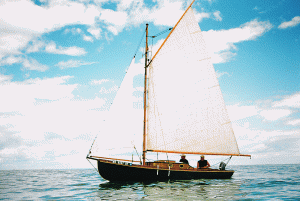
By Chris Maples
The gaff-rigged sloop REEB (Beer spelled backwards) was one of three wooden day sailers built in 1922 for a resort in Sturgeon Bay, Wisconsin. My father purchased it in 1953 and raced and day sailed it for several years along the Door Peninsula. In 1958, he obtained a job at the Defoe Shipyard in Bay City, Michigan; with no means of trailering the REEB, he decided to sail it to Bay City.
The REEB, a typical wood plank construction, was plagued with small leaks. Eventually, my father grew tired of launching the boat, letting it fill with water, waiting for the planks to swell, and then finally pumping the bilge so that he could sail. Not to mention the ongoing task he faced of keeping the bilge dry. So with the aid of his coworkers and one of Defoe’s large cranes, he pulled the boat and turned it over to fiberglass the hull using polyester resin. The metalworkers at Defoe’s also built an aluminum sleeve for the centerboard box, giving the hull additional stiffness as well as preventing further leaks.
With its modifications, my father sailed the REEB in the Saginaw Bay for several years. Then other responsibilities interfered. The sailboat ended up on shore, uncovered, for nearly fifteen years followed by five years in a barn. When the barn was to be demolished, my father asked my brother, Craig, and me if we wanted to restore it; otherwise the REEB would be destroyed. We took the boat.
Mast repairs
Our first work was sporadic, usually done in Craig’s basement. Initial projects included sanding and refinishing the wood mast, gaff and boom. A crack had developed in the mast at the point where the gaff rests when the sail is hoisted. We cleaned out the crack with a chisel and then filled it with WEST SYSTEM® 105/205 until the wood could no longer absorb the epoxy. Then we wrapped the mast with a few layers of 6 oz fiberglass several inches further than the crack in each direction. Finally, we wrapped this with a single piece of 1/32″ copper sheet which not only improved the appearance, but also added abrasion resistance where the gaff meets the mast.
Inspecting and repairing the hull
In the early 90’s, we decided to devote more time and money to the restoration, largely because Delta College Sailing School allowed us to work inside in their new pole barn. First, we removed the deck and cabin and found the majority of the rotted wood was located in the bottom of the hull where water had sat for many years. We removed all of the ribs in that area and removed and sanded away the rotted wood.
In a couple of small areas, the rot was too extensive and we needed to scarf in replacement wood. Since the fiberglass skin on the hull was still in good shape, we were able to remove rotted sections of plank from the inside of the hull, being careful not to disturb the fiberglass. We then scarfed replacement pieces of wood to the existing plank. We wet out these areas with WEST SYSTEM 105/206, then used 105/206 thickened with 404 High-Density Filler to bond in the new plank section.
Many of the ribs that needed to be replaced were located on the very flat portions of the hull so we could use straight pieces of mahogany for rib replacement. To replace a few ribs near the water line, we laminated thin strips of mahogany to the curvature of the hull, building up to the necessary thickness.
Once the ribs were finished, we coated the inside of the hull with WEST SYSTEM 105/206 to provide a good surface for painting. Although this is not a recommended procedure, we wanted to seal the remaining planks that were affected by rot. Time will tell if it was a good idea. After washing and lightly sanding the cured epoxy, we painted with two coats of a gloss white polyurethane.
Deck and cabin repairs
Once the inside of the hull was complete, we began rebuilding the deck. We built the entire deck framework with dry pressure treated lumber. Then we bonded a treated marine grade plywood deck to the frames with epoxy. We would cover this after completing the cabin repairs.
The curved cabin was in pretty good shape except for some rotted wood where the deck joined the cabin. We coated the cabin with WEST SYSTEM 105/206 and then faired it, thickening the epoxy with 407 Low-Density Filler. To finish the cabin, we chose to bond an oak veneer on the curved vertical surface using the two-step bonding method.
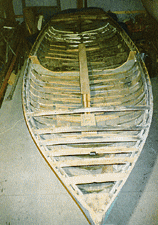
The compound curvature of the cabin made applying the new veneer a difficult project. Spiling was necessary to get the veneer to lie flat around the curved front of the cabin. We had purchased veneer in a roll just a few inches wider than the height of the cabin. When we tried to follow the top of the cabin, the veneer would lift off the bottom half of the cabin as we rounded toward the cockpit coaming. We knew we could use pieces of trim to cover both the top and bottom of the cabin. We decided to place another piece of trim vertically at the front of the cabin. This allowed the two sides of the cabin to be bonded separately. There was still a tendency for the veneer to travel downward, away from the cabin top, as it was wrapped around either side. To solve this problem, we simply started the veneer above the top edge of the cabin and by the time we reached the beginning of the cockpit coaming, the veneer was even with the top.
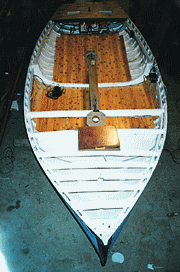
To apply, we coated both the veneer and the cabin with WEST SYSTEM 105/206 and then applied a second layer of epoxy thickened with 406 Colloidal Silica Filler, using a notched trowel. The veneer was held in place by clamping thin strips of wood over the outside of the cabin every six inches, starting from the front and working aft. This allowed us to remove trapped air as we moved along the cabin face. Once the epoxy was cured, the excess veneer was trimmed off at the forward part of the cabin. The outside of the veneer was coated with 3 coats of 105/207 Special Clear Hardener since we wanted a clear finish. Then we applied 6 coats of varnish.
Originally, the deck of the REEB was covered with canvas that was repainted every couple of seasons. Craig and I wanted to recapture this look as it had been recorded in photographs of our father sailing the boat years before. However, we wanted something that would require less upkeep. We chose an inexpensive canvas/vinyl decking material with a built in nonskid surface.
Fairing and finishing the hull exterior
The last big project was finishing the exterior of the hull. As mentioned earlier, my father had covered the hull many years earlier with polyester and fiberglass. This fiberglass shell is essentially what saved the boat and it was still bonded to the planking fairly well. However, at the time the fiber glassing was done, there was little attention paid to fairing the bottom. We decided to leave the fiberglass shell in place and fair it. After sanding off all of the old topside paint and anti-fouling bottom paint, we were faced with an extensive fairing job as well as a few small holes in the fiberglass.
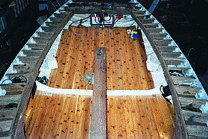
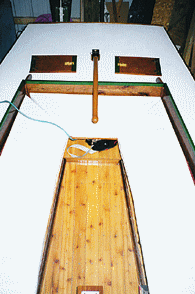
We first coated the exterior with four coats of WEST SYSTEM 105/206, washing the cured epoxy with water and an abrasive pad, followed by light sanding. Then we filled and faired using 105/206/407 to achieve a respectably fair hull. We finished with 3 more coats of epoxy. Finally, we painted the bottom with a polyurethane topside finish. We do plan to use bottom paint in the future, but wanted to first allow a season’s growth on the bottom so we can determine where the waterline is.
Launching and Sailing the restored REEB

We were excited when we finally moved REEB outside, stepped the mast, and began rigging. Since this was the first gaff-rigged sloop Craig and I had worked on, we had to call in our father for help on rigging details.
We launched on Memorial Day, 1999. As we headed out on the Saginaw Bay and raised sail, many heads turned. In this classic gaff-rigged sloop lives a piece of Great Lakes sailing history. We are proud to bring back to life a boat built almost 80 years ago that had been out of the water for over 30 years. The boat is fun to sail. In the future, we hope to build a trailer so we can cruise REEB again in the Door Peninsula and in the North Channel. We want others to see and enjoy this day sailer of another age.
